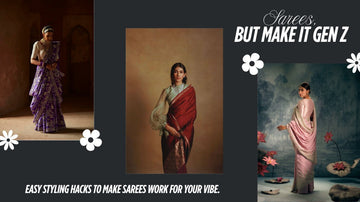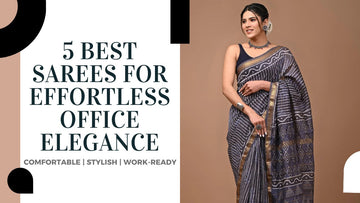What Are the Different Types of Cotton Fabric Used for Sarees?
Cotton sarees are a symbol of grace, comfort, and culture. Worn across India in every region and climate, they blend tradition with everyday practicality. But did you know there are various types of cotton used to make sarees, each with its own texture, fall, and feel? Let’s explore them.
Why Cotton Sarees Are Timeless
Cotton sarees are breathable, easy to wear, and ideal for India's tropical climate. They can be styled up or down, depending on the occasion, and they never go out of fashion.
What Makes Cotton Ideal for Sarees?
Cotton is known for:
- Breathability
- Soft texture
- High moisture absorbency
- Durability
These qualities make it the perfect fabric for daily wear, festive looks, and even formal events.
Types of Cotton Used in Sarees
Pure Cotton
The most basic and extensively used cotton is this one. It’s soft, lightweight, and ideal for regular wear. It absorbs sweat and lets your skin breathe, which makes it perfect for summer.
Organic Cotton
Grown without harmful chemicals, organic cotton is environmentally friendly and gentle on sensitive skin. Sarees made from organic cotton are gaining popularity among eco-conscious buyers.
Jamdani Cotton
Jamdani cotton is a handwoven marvel that combines artistry and tradition. Originating in Bengal and Bangladesh, it features intricate motifs like flowers, vines, or paisleys that are woven directly into the fabric, not printed. The outcome is a beautifully lightweight and elegantly designed saree, crafted specifically for unforgettable special occasions. Its exquisite craftsmanship ensures a unique quality, making it a timeless heirloom piece worthy of passing down through generations.
Mulmul Cotton
Mul cotton, also known as mulmul, is an exceptionally soft, breathable, and lightweight cotton fabric. Originating in India, it is ideal for summer sarees because of its airy texture. Despite its thinness, it drapes beautifully and is easy to pleat. Many designers use it for hand-block prints and minimalistic designs. It’s ideal for daily wear or casual festive looks.
Cambric Cotton
Tightly woven and slightly stiff, cambric cotton holds prints beautifully. It's often used in printed cotton sarees that are both trendy and traditional.
Chanderi Cotton
Originating in Madhya Pradesh, Chanderi cotton is an opulent fabric composed of a combination of cotton and silk. It is well known for its rich feel, sheer texture, and lightweight. These sarees often feature zari or brocade borders and motifs like peacocks, lotuses, or geometric patterns. Chanderi cotton sarees are ideal for festive occasions, religious ceremonies, and weddings.
Cotton Silk Blend
Cotton silk is a type of fabric that blends the elegance and sheen of silk with the comfort and durability of cotton. These sarees have a silky texture and a little shimmer. They’re easy to maintain and perfect for semi-formal events or traditional functions. Cotton silk comes in various vibrant colors and woven patterns.
Handloom Cotton
Handloom cotton is woven on manual looms by artisans. These sarees celebrate and support local craftsmanship, exuding a captivating rustic and artistic charm that makes them truly unique.
Khadi Cotton
Khadi cotton is hand-spun and handwoven, making it a symbol of sustainability and Indian heritage. It’s slightly coarse but very durable, with a unique texture that becomes softer after each wash. Khadi sarees usually come in earthy tones and are perfect for formal, office, or ethnic day wear. They reflect simplicity and understated elegance.
Chettinad Cotton
Chettinad cotton sarees, which come from Tamil Nadu, are renowned for their striking checks, vivid hues, and contrasting borders. They are both stylish and functional.
Regional Variations in Cotton Sarees
Bengal Cotton Sarees
These sarees, like the Tant and Jamdani, are known for intricate handwoven patterns and lightness. They’re perfect for daily wear with a touch of elegance.
South Cotton Sarees
South cotton is a thicker variant of cotton, primarily produced in Tamil Nadu and Andhra Pradesh. Bold colors, temple borders, and checkered or striped patterns characterize these sarees. They're slightly heavier than other cottons, making them ideal for those who prefer a structured drape. Great for festivals, daily wear, or college functions.
Maharashtrian Cotton Sarees
Paithani cotton and Narayan Peth sarees from Maharashtra are woven with rich borders and traditional motifs, suitable for festive occasions.
How to Choose the Right Cotton Saree
- Event: For celebrations, choose silk combinations or Chanderi cotton.
- Climate: Choose mulmul or pure cotton in hot weather.
- Style: Opt for cambric or printed handlooms for a stylish look.
Caring for Your Cotton Saree
- Always handwash it or use gentle machine settings.
- Dry in shade to avoid color fading.
- Store in a cool, dry place with a muslin cloth wrap.
- Iron on low heat to maintain fabric texture.
Modern Designs in Cotton Sarees
Contemporary cotton sarees now feature digital prints, geometric patterns, ruffled borders, and even pocket designs! Designers are reimagining cotton for the fashion-forward woman.
Sustainable Fashion and Cotton Sarees
With growing awareness of eco-friendly fashion, cotton sarees — especially those made of organic and handloom cotton — are becoming symbols of slow, sustainable style. They’re biodegradable, renewable, and socially impactful.
From daily comfort to festive elegance, cotton sarees offer endless options. Understanding the types of cotton helps you choose better — whether it’s for tradition, style, or sustainability. So, next time you pick a cotton saree, you’ll know what’s wrapped around you: history, art, and purpose.









